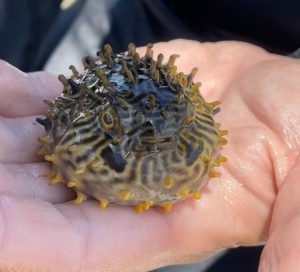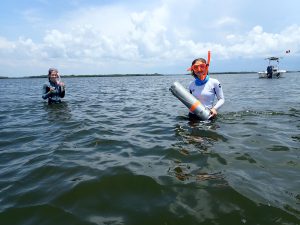Written by 2021 UF/IFAS NCBS Summer Intern, Chloe Spengler
 Introduction
Introduction
This summer I had the amazing opportunity of working on various projects in Laura Reynold’s lab, primarily with graduate student Jamila Roth. Whether I was in the lab or out in the field, I was always learning something new.

In the Lab
When the summer first started, I did a variety of tasks in the lab. However, as the summer went on I spent most of my time identifying invertebrates for one of Jamila’s projects that looks at how seagrass species diversity impacts invertebrate communities. I had fun with this, although it did get frustrating not being able to identify one amphipod and then getting 151 more of the same species. However, this only fueled my determination more. I was surprised with how much I enjoyed working with invertebrates.
 On the Water
On the Water
In the beginning, my field days consisted of helping wherever it was needed ranging from Crystal River to Cedar Key. I got to take sediment cores for Alex Bijak’s experiment, which is looking at how seagrass species identity influences greenhouse gas production. I helped collect more seagrass invertebrate samples that I would later pick through in the lab. I also got to help collect water samples for project COAST, which is a water quality monitoring program for the new Nature Coast Aquatic Preserve.
Later in the summer, we started Jamila’s field experiment which is being used to look at how seagrass species diversity impacts seagrass resilience to disturbances, specifically grazing. This consisted of going out every other week to simulate grazing (cut the seagrass plots with scissors), and to measure how the plants responded (the height and number of seagrass shoots). This sounds easy, but imagine having to count blades of grass, only you’re holding your breath underwater. I did enjoy the challenge though.
 Some field days we would also collect some samples using a benthic sled for Adam Searles, who is exploring how fish and invertebrate communities vary between seagrass-dominated and macroalgae-dominated habitats. I got to see some really cool critters from this. Adam tried to teach me the fish species, but my brain was too full with invertebrate species names to remember.
Some field days we would also collect some samples using a benthic sled for Adam Searles, who is exploring how fish and invertebrate communities vary between seagrass-dominated and macroalgae-dominated habitats. I got to see some really cool critters from this. Adam tried to teach me the fish species, but my brain was too full with invertebrate species names to remember.
Even if it was pouring rain (which was pretty frequent), I still enjoyed every second we were out in the field. It was very hard not to appreciate all that was around me. If you asked me what I learned out in the field, I should to tell you that I learned about different sampling techniques, how to identify various marine species, and how tricky field experiments can be. However, I would prefer to tell you I learned that dolphins like to mess with researchers, blue crabs sometimes catch a ride on floating seagrass clumps, and, most importantly, you can still get sunburnt when it’s cloudy.
 What Comes Next
What Comes Next
I have the opportunity to continue working in the Coastal and Marine Ecology Lab into the school year. I will get to be an author on Jamila’s papers, continue working with the invertebrates, and do my own research project on seagrass consumption by parrotfish. I am grateful for this NCBS internship, because I was introduced to a lab that I really love working in.
 0
0
